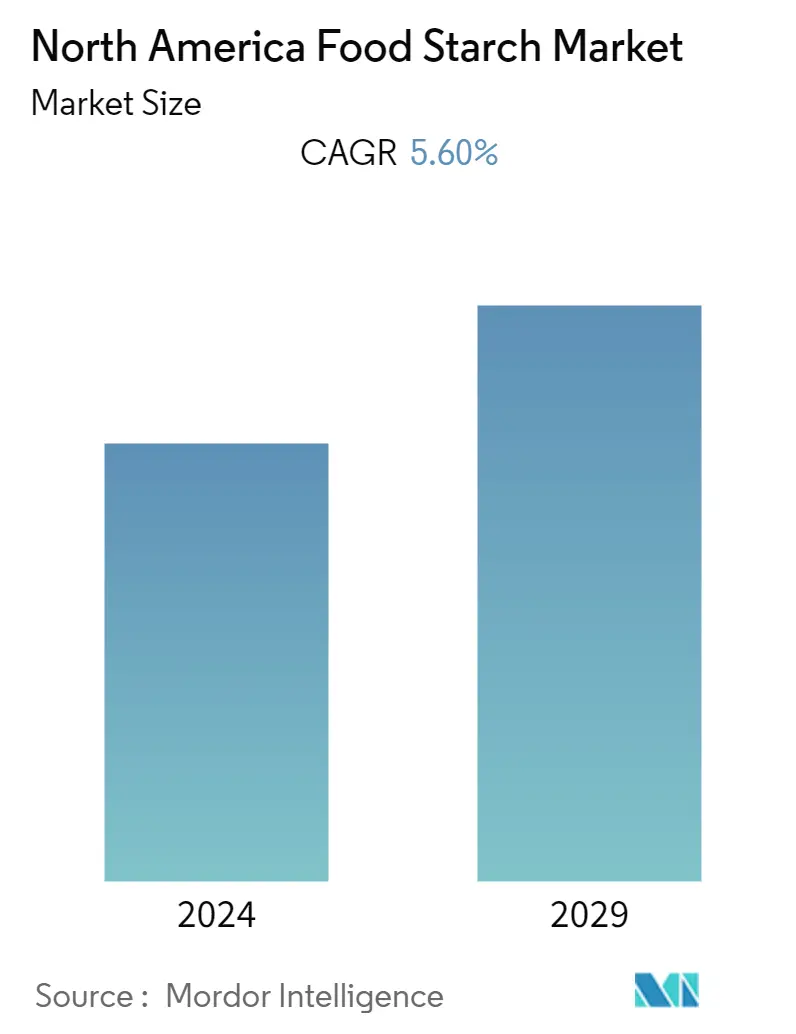Market Size of North America Food Starch Industry

| Study Period | 2019 - 2029 |
| Base Year For Estimation | 2023 |
| Forecast Data Period | 2024 - 2029 |
| Historical Data Period | 2019 - 2022 |
| CAGR | 5.60 % |
| Market Concentration | Low |
Major Players
*Disclaimer: Major Players sorted in no particular order |
North America Food Starch Market Analysis
The North American food starch market is projected to register a CAGR of 5.6% during the forecast period, 2022-2027.
Food starch has a significant part in the food industry that is widely used in the production of various food products including convenience food products, bakery, and confectionery products owing to its stabilizing property and nutritional benefits. With growing consumer demand for all-natural ingredients in food products, the demand for food starch is increasing rapidly and the market is highly competitive. Moreover, the abundance of raw supplies integrated into the supply chain and diversified usage of starch across the end-use industries are the factors boosting the demand for food starch in the North American region. However, the COVID-19 pandemic has negatively impacted starch production due to the lack of resources and disruption in the supply chain of raw materials.
In recent years, consumers' demand for ready-to-eat food products has increased due to changing lifestyles and high disposable income. Several RTE and packed foods contain starch; hence, the demand for food starch is expected to drive market growth in the next few years. In addition, the growing trend for clean label products is further promoting the growth of clean label starch in the market as it is Non-GMO and chemical free. This has created an opportunity for the players to produce new products in the market. For instance, in April 2022, Ingredion Inc., launched NOVATION Lumina 8300 functional rice starch specially for the consumer who prefer the clean label products.
North America Food Starch Industry Segmentation
Starch is a polymeric glucose carbohydrate that can be modified to improve stability, heat resistance, and control viscosity. The North America food starch market (henceforth referred to as the market studied) is segmented by type, source, application, and country. By type, the market is segmented into native and modified. Based on the source, the market is segmented into corn, potato, wheat, tapioca, rice, and others. Based on the application, the market studied is segmented into bakery, dairy, confectionery, convenience foods & beverages, and others. It provides an analysis of emerging and established economies across North America, comprising the United States, Canada, Mexico, and the Rest of North America. For each segment, the market sizing and forecasts have been done on the basis of value (in USD million).
| By Type | |
| Native Starch | |
| Modified Starch |
| By Source | |
| Corn | |
| Potato | |
| Wheat | |
| Tapioca | |
| Rice | |
| Others |
| By Application | |
| Bakery | |
| Dairy | |
| Confetionery | |
| Convenince Foods | |
| Beverages | |
| Others |
| By Geography | |
| United States | |
| Canada | |
| Mexico | |
| Rest of North America |
North America Food Starch Market Size Summary
The North American food starch market is experiencing significant growth, driven by the increasing demand for natural and clean label ingredients in the food industry. Food starch is essential in the production of various food products, including convenience foods, bakery items, and confectionery, due to its stabilizing and nutritional properties. The market is highly competitive, with abundant raw materials and diverse applications across end-use industries contributing to its expansion. However, the COVID-19 pandemic posed challenges by disrupting supply chains and affecting starch production. The rising consumer preference for ready-to-eat foods, coupled with higher disposable incomes, is further propelling market growth. The trend towards clean label products, which are non-GMO and chemical-free, is creating opportunities for innovation, as seen with companies like Ingredion Inc. launching new products to cater to this demand.
The demand for modified starches is also on the rise, particularly in the processed food industry, where they are used to enhance the texture and stability of products such as sauces and dairy desserts. This trend is supported by the increasing consumption of processed and convenience foods in the region. The market is characterized by a high level of fragmentation, with numerous global and regional players like Cargill Incorporated, Agarna, and Archer-Daniels-Midland competing on factors such as price, product customization, and customer service. These companies are focusing on product innovation to expand their market presence and meet the diverse needs of food manufacturers. The evolving retail landscape and the involvement of both global and local players in the prepared food sector are expected to further boost the demand for modified starches in North America.
North America Food Starch Market Size - Table of Contents
-
1. MARKET DYNAMICS
-
1.1 Market Drivers
-
1.2 Market Restraints
-
1.3 Porter's Five Force Analysis
-
1.3.1 Threat of New Entrants
-
1.3.2 Bargaining Power of Buyers/Consumers
-
1.3.3 Bargaining Power of Suppliers
-
1.3.4 Threat of Substitute Products
-
1.3.5 Intensity of Competitive Rivalry
-
-
-
2. MARKET SEGMENTATION
-
2.1 By Type
-
2.1.1 Native Starch
-
2.1.2 Modified Starch
-
-
2.2 By Source
-
2.2.1 Corn
-
2.2.2 Potato
-
2.2.3 Wheat
-
2.2.4 Tapioca
-
2.2.5 Rice
-
2.2.6 Others
-
-
2.3 By Application
-
2.3.1 Bakery
-
2.3.2 Dairy
-
2.3.3 Confetionery
-
2.3.4 Convenince Foods
-
2.3.5 Beverages
-
2.3.6 Others
-
-
2.4 By Geography
-
2.4.1 United States
-
2.4.2 Canada
-
2.4.3 Mexico
-
2.4.4 Rest of North America
-
-
North America Food Starch Market Size FAQs
What is the current North America Food Starch Market size?
The North America Food Starch Market is projected to register a CAGR of 5.6% during the forecast period (2025-2030)
Who are the key players in North America Food Starch Market?
ADM, Ingredion Inc, Cargill Inc., AGRANA Beteiligungs-AG and Tate & Lyle are the major companies operating in the North America Food Starch Market.

